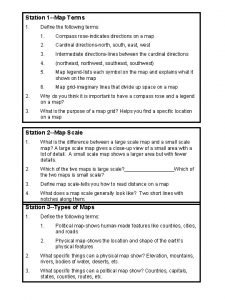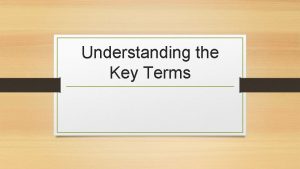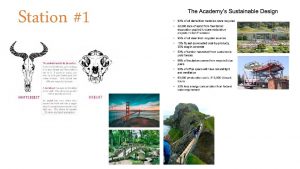Station 1 Map Terms 1 Define the following



- Slides: 3

Station 1 --Map Terms 1. Define the following terms: 1. Compass rose-indicates directions on a map 2. Cardinal directions-north, south, east, west 3. Intermediate directions-lines between the cardinal directions 4. (northeast, northwest, southeast, southwest) 5. Map legend-lists each symbol on the map and explains what it shows on the map 6. Map grid-imaginary lines that divide up space on a map 2. Why do you think it is important to have a compass rose and a legend on a map? 3. What is the purpose of a map grid? Helps you find a specific location on a map Station 2 --Map Scale 1. What is the difference between a large scale map and a small scale map? A large scale map gives a close-up view of a small area with a lot of detail. A small scale map shows a larger area but with fewer details. 2. Which of the two maps is large scale? _________Which of the two maps is small scale? 3. Define map scale-tells you how to read distance on a map 4. What does a map scale generally look like? Two short lines with notches along them. Station 3 --Types of Maps 1. Define the following terms: 1. Political map-shows human-made features like countries, cities, and roads 2. Physical map-shows the location and shape of the earth’s physical features 2. What specific things can a physical map show? Elevation, mountains, rivers, bodies of water, deserts, etc. 3. What specific things can a political map show? Countries, capitals, states, counties, routes, etc.

Station 4 --Reading a Relief Map 1. What is a relief map? A map that shows variation in height or elevation of land areas 2. All elevation is measured from what point? Sea level (0) 3. When the elevation of a place is a negative number, what does that mean? That location is lower than sea level 4. What do relief maps use to identify elevation? Colors or shaded areas 5. What elevation on the map is the darkest color? Station 5 --Interpreting a Climate Map 1. What does a climate map show? The climate zones of a region 2. What factors help determine climate? Latitude, temperature, precipitation, altitude, wind patterns, and nearness to oceans 3. On a climate map, what represents different climate regions? Colors 4. What climate dominates the most northern part of Canada? 5. Quebec, Ontario, and Manitoba have what type of climate? 6. What area of Canada has a humid continental climate? Station 6 --Reading a Population Density Map 1. What does population density measure? How many people live within a certain unit area 2. How can you find the population density of a country? Divide the number of people within a country’s boundaries by its land area in square miles 3. What does the dark bold square represent on the map of Brazil? 4. What does the lightest color on the map represent on the map? 5. What are the two most populous cities in Brazil? 6. Where is the least populated area of Brazil?

Station 7 --Reading a Vegetation Map 1. Define vegetation-the plant life that grows naturally in an area 2. What two factors greatly affect vegetation? Climate and elevation 3. Areas with less than 10 inches of rain can only support what type of vegetation? Desert scrub 4. Most of Turkmenistan is what vegetation? 5. The central part of the map is what type of vegetation? 6. Where can you find the highlands? Station 8 --Reading an Economic Map 1. What does an economic map show? Economic resources and activities 2. In what different ways can economic maps show information? Colors, patterns, symbols 3. Most of the Korean Peninsula participates in what type of land use? 4. The other major type of land use in Korea is ______, and this is located ________. 5. The lightening bolt represents what on the map? 6. What type of crop does Korea produce? Station 9 --Understanding Cartograms 1. What is a cartogram? A map in which size is based on some characteristic other than land area, such as population or economic factors 2. How does a cartogram differ than other maps? It does not draw land areas proportional to their actual surface areas 3. What types of characteristics can a cartogram show? Population, economic factors 4. What type of information does the cartogram on the page represent? Population growth rate 5. What characteristics determine the color of the square on this cartogram? 6. What does each square represent on the map? 7. What is the most populous country on this map?




